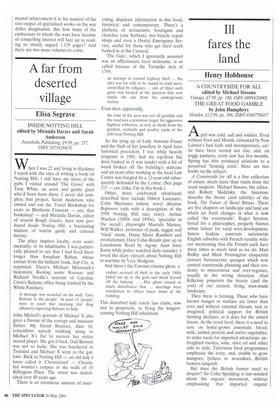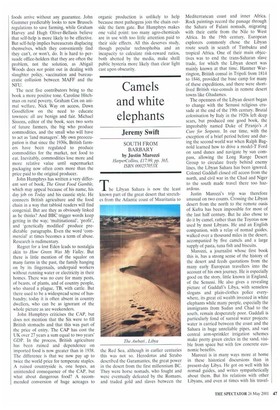Ill fares the land
Henry Hobhouse
A COUNTRYSIDE FOR ALL edited by Michael Sissons Vintage, £7.99, pp. 188, ISBN 009942889X THE GREAT FOOD GAMBLE by John Humphrys Hodder, £12.99, pp. 306, ISBN 0340770457 April was cold, sad and sodden. Even without Foot and Mouth, enhanced by New Labour's bad faith and incompetence, cattle have been turned out late, and, on soggy pastures, every cow has five mouths. Spring has also produced solutions to a perceived 'farming crisis'. Here are two books on the subject.
A Countryside for All is a fine collection of essays, much more than tracts from the usual suspects. Michael Sissons, the editor, and Robert Skidelsky, the historian, describe the theme (and subtitle) of the book, The Future of Rural Britain. There are five chapters on landscape and land use which set forth changes in what is now called 'the countryside'. Roger Scniton, lyrical for a philosopher, properly blames urban failure for rural over-development. Simon Jenkins contrasts nationwide English suburbia with French rurality without mentioning that the French each have three times as much land as we do. Matt Ridley and Mark Pennington eloquently censure bureaucratic quangos which now control countryside planning and their tendency to misconstrue and over-regulate, usually in the wrong direction. Alan Kilkenny pinpoints the beauty (and the cost) of our ancient, living, man-made landscape.
Then there is farming. Those who have known hunger or warfare are fewer than ever and without external threats, real or imagined, political support for British farming declines, as it does for the armed forces. At the retail level, there is a need to save on home-grown essentials: bread, milk, animal protein and native vegetables, to make room for imported attractions: airfreighted exotica, wine, olive oil and other aids to style. Television food programmes emphasise the irony, and, unable to grow mangoes, lychees or avocadoes, British farmers languish.
But does the British farmer need to despair? Sir Colin Spedding is fair-minded about the organic movement, without emphasising that imported organic
foods arrive without any guarantee. John Gummer predictably looks to new Brussels regulations to save farming, while Graham Harvey and Hugh Oliver-Bellasis believe that self-help is more likely to be effective. But self-help implies bureaucrats displacing themselves, which they conveniently find they can't, or won't, do. It is hard to persuade office-holders that they are often the problem, not the solution, as Abigail Woods does not point out in dealing with slaughter policy, vaccination and bureaucratic collusion between MAFF and the NFU.
The next five contributors bring to the book a more positive tone. Caroline Hitchman on rural poverty, Graham Cox on animal welfare, Nick Way on access, Dawn Goodfellow on the need to educate townees: all are benign and fair. Michael Sissons, editor of the book, sees two sorts of future farmers, the big who produce commodities, and the small who will have to act as `land managers'. My own preoccupation is that since the 1930s, British farmers have been regulated to produce commodities for the market, not food to eat. Inevitably, commodities lose more and more relative value until supermarket packaging now often costs more than the price paid to the original producer.
John Humphrys has written a very different sort of book, The Great Food Gamble, which may appeal because of his name, his day job on Today and his caustic style. He connects British agriculture and the food chain in a way that tabloid readers will find congenial. But are they as obviously linked as he thinks? And BBC trigger words keep getting in the way; 'multinational', 'profit', and 'genetically modified' produce predictable paragraphs. Even the word 'commercial' at times becomes a term of abuse. Research is rudimentary.
Regret for a lost Eden leadsto nostalgia akin to How Green Was My Valley. But there is little mention of the squalor on many farms in the past, the family hanging on by its fingernails, underpaid workers without running water or electricity in their homes. There was no cure for many pests, of beasts, of plants, and of country people, who shared a plague, TB, with cattle. But there used to be a widespread sense of husbandry; today it is often absent in country dwellers, who can be as ignorant of the whole picture as are weekenders.
John Humphrys criticises the CAP, but does not mention that the Six were to fill British stomachs and that this was part of the price of entry. The CAP has cost the UK over 27 years a sum equal to two years' GDP. In the process, British agriculture has been ruined and dependence on imported food is now greater than in 1938. The difference is that we now pay up to twice the world price for temperate staples. A ruined countryside is, one hopes, an unintended consequence of the CAP, but what about dangerous food? A recommended conversion of huge acreages to organic production is unlikely to help because most pathogens join the chain outside the farm gate. But Humphrys makes one valid point: too many agro-chemicals are in use with too little attention paid to their side effects. All this deserves study, though popular technophobia and an incapacity to calculate risk-reward ratios, both abetted by the media, make shrill public hysteria more likely than clear light cast upon obscurity.



















































































 Previous page
Previous page